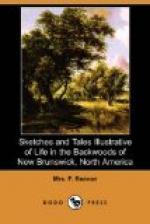have fallen or been removed during the winter.
This, with attending to the stock, which at this season
require particular care, gives them sufficient occupation—the
sheep, which have long since been wearied of the “durance
vile” which bound them to the hay-rick, may now
be seen in groups on the little isles of emerald green
which appear in the white fields; and the cattle,
that for six long weary months have been ruminating
in their stalls, or “chewing the cud of sweet
and bitter fancy” in the barn yards, now begin
to extend their perigrinations towards the woods,
browsing with delight on the sweet young buds of the
birch tree. At this season it is, for obvious
reasons, desirable that the “milky mothers”
should not stray far from home—many “a
staid brow’d matron” has disappeared in
the spring, and, after her summer rambles in the woods,
returned in the “fall” with her full-grown
calf by her side, but many a good cow has gone and
been seen no more, but as a white skeleton gleaming
among the green leaves. To prevent these mischances,
a bell is fastened on the leader of the herd, the
intention of which is to guide where they may be found.
This bell is worn all summer, as their pasture is
the rich herbage of the forest. It is taken off
during the winter, and its first sounds now tell us,
although the days are cold, and the snow not yet gone,
that brighter times are coming. The clear concerts
of the frogs ring loudly out from marsh and lake, and
at this season alone is heard the lay of the wood-robin,
and the blackbird. The green glossy leaves of
the winter green, whose bright scarlet berries look
like clusters of coral on the snow, now seem even brighter
than they were—the blue violet rises among
the sheltered moss by the old tree roots, and the
broad-leaved adder tongue gives out its orange and
purple blossoms to gladden the brown earth, while the
trees are yet all black and barren, save the various
species of pine and spruce, which now wear a fringe
of softer green. The May flowers of New Brunswick
seldom blossom till June, which is rather an Irish
thing of them to do, and although the weather has
been fine, and recalls to the memory the balmy breath
of May, yet I have often seen a pearly wreath of new
fallen snow, deck the threshhold on that ‘merrie
morn’. After the evaporation of the steaming
vapour of spring has gone forward, and the farmer has
operated in the way of ploughing and sowing, on whatever
ready-prepared land he may have for the purpose, the
first dry “spell” is looked forward
to most anxiously to burn off the land which has been
chopped during the winter—it is bad policy,
however, to depend for the whole crop on this “spring
burn,” as a long continuance of wet weather
may prevent it. The new settler, on his first
season, has nothing else to depend upon; but the older
ones chop the land at intervals during the summer,
and clear it off in the autumn, and thus have it ready
for the ensuing spring. Burning a chopping, or




